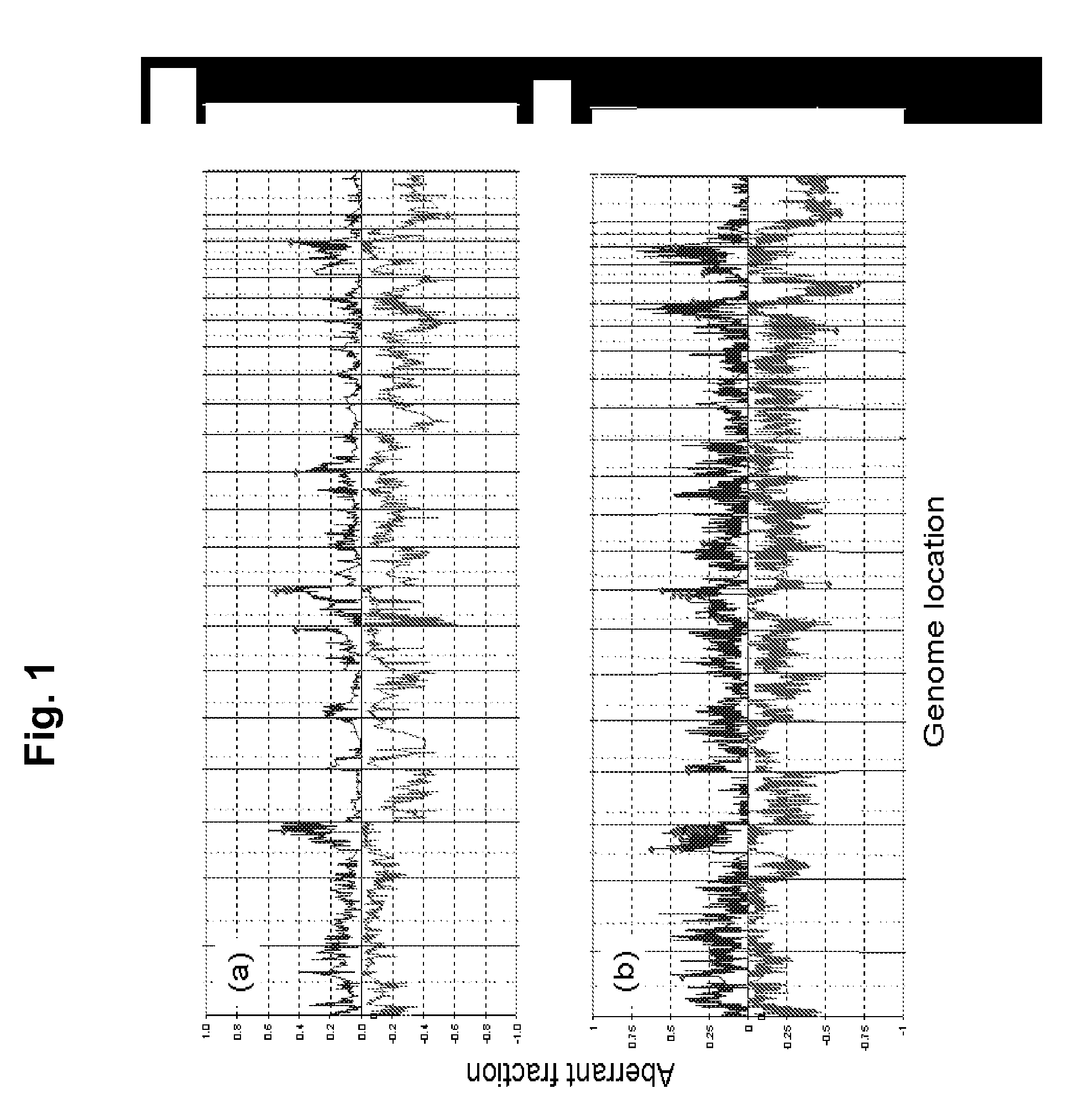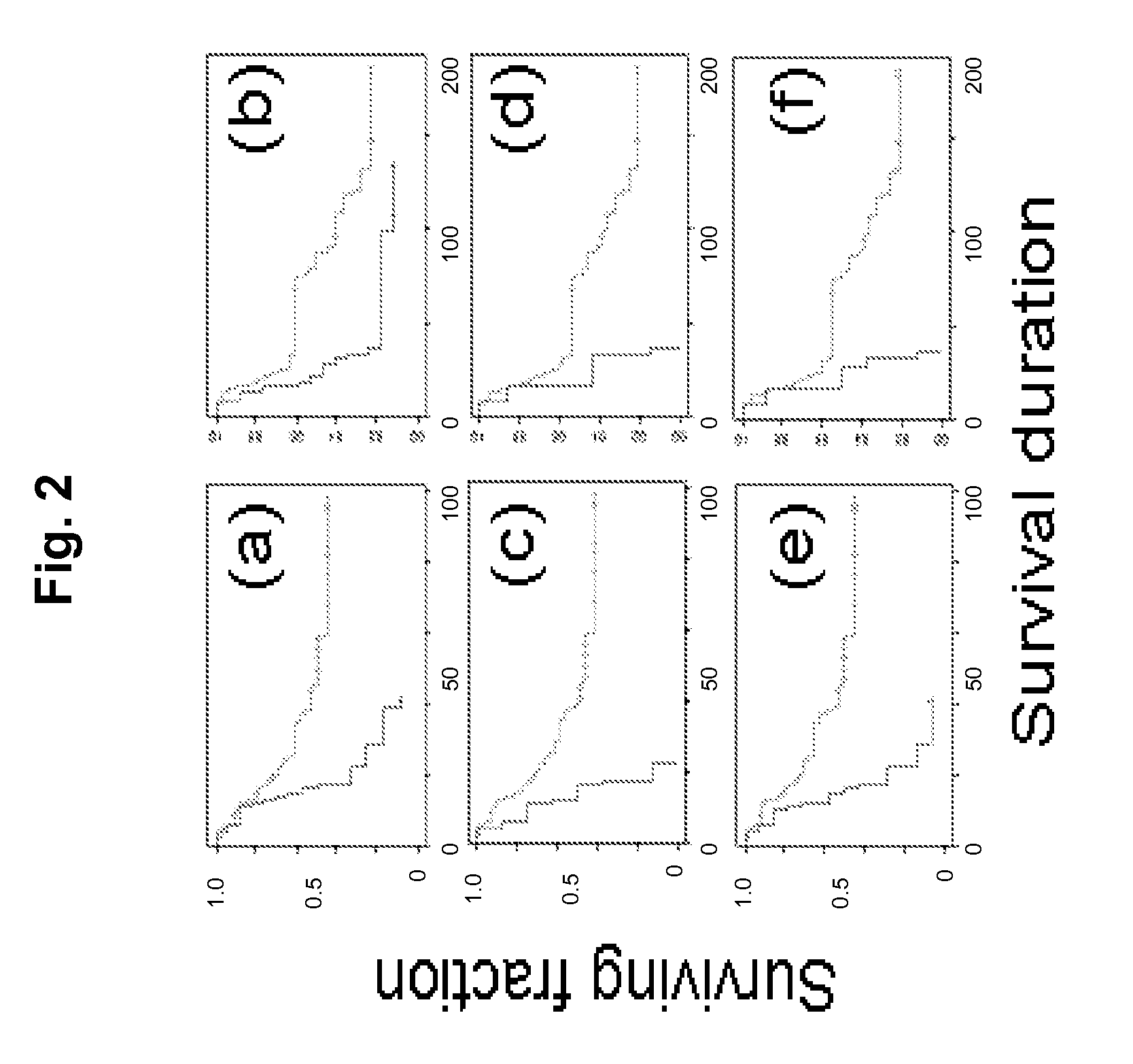Predictive and Therapeutic Markers in Ovarian Cancer
a technology of ovarian cancer and markers, applied in the field of predictive and therapeutic markers in ovarian cancer, can solve the problems of insufficient evidence now exists to identify apoptosis suppressing genes, variable response rate, and contribute to lethality, so as to reduce the survival duration of ovarian tumors, reduce proliferation, and reduce the effect of the survival ra
- Summary
- Abstract
- Description
- Claims
- Application Information
AI Technical Summary
Benefits of technology
Problems solved by technology
Method used
Image
Examples
example 1
Identifying a Candidate Gene
[0167]Marker development. We applied array comparative genomic hybridization (CGH) and expression profiling to localize aberrant genes in three independent sets of stage 3 and 4 serous ovarian cancers for which clinical outcome information was available. All patients were staged according to the guidelines of FIGO (Shepherd, J. H. Revised FIGO staging for gynaecological cancer. Br J Obstet Gynaecol 96, 889-92 (1989)). We analyzed genome copy number abnormalities using array CGH with BAC arrays (Hodgson, G. et al. Genome scanning with array CGH delineates regional alterations in mouse islet carcinomas. Nat Genet. 29, 459-64 (2001); Snijders, A. M. et al. Assembly of microarrays for genome-wide measurement of DNA copy number. Nat Genet. 29, 263-4 (2001)) in all three studies. We analyzed gene expression in two studies using the Affymetrix U133A array platform (Lancaster, J. M. et al. Gene expression patterns that characterize advanced stage serous ovarian c...
example 2
Developing a Tri-Locus Assay
[0195]One goal is to develop a robust tri-locus assay to stratify patient outcome. A FISH assay is ideally suited as a simple, easy and robust assay. To do so we need to validate the tri-locus classifier identified in the array CGH dataset in Example 1 with FISH probes. Development of a robust tri-locus FISH assay will require optimization of the probe, hybridization conditions and scoring procedures.
[0196]Probes. One key to development of a robust assay that can be applied to paraffin embedded samples is development of probes that span minimally several hundred kilobases centered on each region of interest. We will accomplish this by selecting FISH probes comprised of contiguous BACs covering each locus.
[0197]We have already applied this approach to develop probes for early ovarian cancer detection. FIG. 4, for example shows FISH with probes to regions of recurrent copy number increase at 3q26 and 8q24 Probe DNA from the EVI1 locus was labeled with a red...
example 3
Tri-Locus FISH Assay Used to Stratify Patient Outcome
[0203]The tri-locus FISH assay developed in Example 2 will be used to stratify patients according to outcome in three retrospective analyses: (1) 70 samples from patients treated with platinum / taxol at MDACC on GOG protocol 0152; (2) 110 samples from patients treated at MDACC on GOG protocol 0182; (3) 1300 samples from patients treated with carboplatin under protocol SCOTRCO4.
[0204]Approaches. These studies will explore the robustness of the assay for amplification developed in Example 1 against changes in therapy. Study 1.b.i. is a direct, small-scale validation of the assay developed in Example 2. Patients in this study were treated on platinum / taxol based protocols similar to those used in the studies on which the assay is based. Patients in study 1.b.ii. were treated with a variety of therapeutic agents including carboplatin / pacitaxel. Successful stratification of patients in this cohort will indicate that the stratification p...
PUM
| Property | Measurement | Unit |
|---|---|---|
| Fraction | aaaaa | aaaaa |
| Therapeutic | aaaaa | aaaaa |
| Antisense | aaaaa | aaaaa |
Abstract
Description
Claims
Application Information
 Login to View More
Login to View More - R&D
- Intellectual Property
- Life Sciences
- Materials
- Tech Scout
- Unparalleled Data Quality
- Higher Quality Content
- 60% Fewer Hallucinations
Browse by: Latest US Patents, China's latest patents, Technical Efficacy Thesaurus, Application Domain, Technology Topic, Popular Technical Reports.
© 2025 PatSnap. All rights reserved.Legal|Privacy policy|Modern Slavery Act Transparency Statement|Sitemap|About US| Contact US: help@patsnap.com



